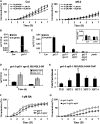MOTHER OF FT AND TFL1 regulates seed germination through a negative feedback loop modulating ABA signaling in Arabidopsis
- PMID: 20551347
- PMCID: PMC2910974
- DOI: 10.1105/tpc.109.073072
MOTHER OF FT AND TFL1 regulates seed germination through a negative feedback loop modulating ABA signaling in Arabidopsis
Abstract
Abscisic acid (ABA) and gibberellin (GA) are two antagonistic phytohormones that regulate seed germination in response to biotic and abiotic environmental stresses. We demonstrate here that MOTHER OF FT AND TFL1 (MFT), which encodes a phosphatidylethanolamine-binding protein, regulates seed germination via the ABA and GA signaling pathways in Arabidopsis thaliana. MFT is specifically induced in the radical-hypocotyl transition zone of the embryo in response to ABA, and mft loss-of-function mutants show hypersensitivity to ABA in seed germination. In germinating seeds, MFT expression is directly regulated by ABA-INSENSITIVE3 (ABI3) and ABI5, two key transcription factors in ABA signaling pathway. MFT is also upregulated by DELLA proteins in the GA signaling pathway. MFT in turn provides negative feedback regulation of ABA signaling by directly repressing ABI5. We conclude that during seed germination, MFT promotes embryo growth by constituting a negative feedback loop in the ABA signaling pathway.
Figures







References
-
- Abe M., Kobayashi Y., Yamamoto S., Daimon Y., Yamaguchi A., Ikeda Y., Ichinoki H., Notaguchi M., Goto K., Araki T. (2005). FD, a bZIP protein mediating signals from the floral pathway integrator FT at the shoot apex. Science 309: 1052–1056 - PubMed
-
- Bradley D., Ratcliffe O., Vincent C., Carpenter R., Coen E. (1997). Inflorescence commitment and architecture in Arabidopsis. Science 275: 80–83 - PubMed
-
- Carmel-Goren L., Liu Y.S., Lifschitz E., Zamir D. (2003). The SELF-PRUNING gene family in tomato. Plant Mol. Biol. 52: 1215–1222 - PubMed
-
- Carmona M.J., Calonje M., Martinez-Zapater J.M. (2007). The FT/TFL1 gene family in grapevine. Plant Mol. Biol. 63: 637–650 - PubMed
Publication types
MeSH terms
Substances
Associated data
- Actions
- Actions
- Actions
LinkOut - more resources
Full Text Sources
Other Literature Sources
Molecular Biology Databases
Research Materials

